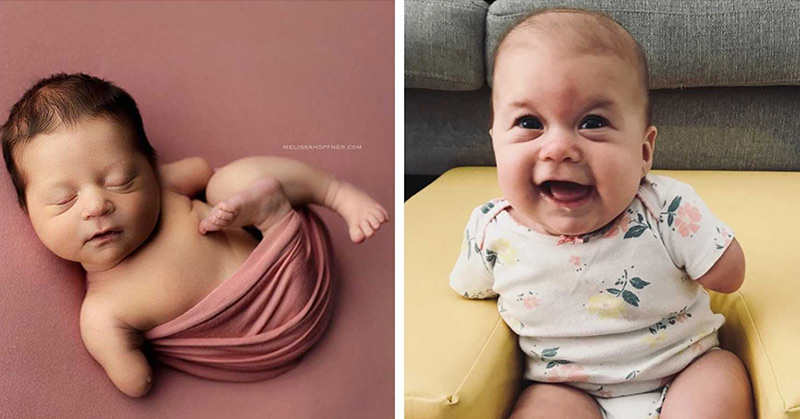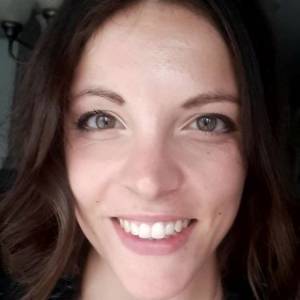Even in today’s modern world with state-of-the-art hospitals and advanced medicine, pregnancy and childbirth come with a certain amount of risk. For this reason, every time a baby is born healthy with no complications it is truly a miracle. Sometimes, however, things don’t go perfectly, and babies are born with health issues that the doctors can’t explain. This can be extremely scary and heartbreaking for the child’s parents, who are not only afraid for the health of their baby, but are unsure whether they’ll be able to provide everything that child will need as they grow up. Vanessa Mcleod and her husband know exactly what that feels like, having experienced the same pain, sadness, and fear after they learned that their unborn baby girl was going to be born with no arms and no hands.
A Baby Girl with No Arms and No Hands
When Vanessa Mcleod received a phone call from her midwife after a routine ultrasound, she knew something was terribly, horribly wrong. Her midwife had told her over the phone that there were “significant findings” in the ultrasound, that she should bring her husband with her to the appointment, and that she should find someone to look after her two-year-old daughter.
Her husband was out of town for work, so instead her mother and father came to the appointment with her. Vanessa cried the entire way, fearing the worst. All she could think was that she did not want to lose her baby.
Upon reviewing the scan of her unborn child, she learned there was a possibility of a cleft lip, that one of her baby’s femurs was curved and shorter than the other, that the doctors had some concerns with her heart, and that she was missing both of her forearms and hands.
That final blow was more than the young mother could take.
“This felt like a punch to the gut. It stole my breath. It keeled me over and the sobs tore out of me, and visions of my perfect little baby shattered,” said Mcleod [1].
Her biggest concern had been that her pregnancy wasn’t viable, or that there was something wrong that would make it impossible for her baby to survive- that she would give birth to her little girl only to lose her shortly after. The thought of her being born without arms or hands had never even crossed her mind.
Grieving
Over the next few months, Vanessa went through a grieving process as she attempted to process this new information. She felt denial, guilt, anger, and sadness. To make matters worse, doctors, perinatologists, medical geneticists, and genetics counselors had very few answers for the shaken family.
All she hoped for were answers- a reason why this was happening, a possible solution.
“But the appointments were severely disappointing in that regard, and if anything, the doctors created more questions for us than answers, and tainted that whole experience with so much negativity,” said Mcleod [1].
From Vanessa’s perspective, it felt as though the doctors were telling her it was all over. She and her husband were shocked when they suggested they terminate the pregnancy, saying that without arms and hands, the little girl would have no quality of life.
Vanessa asked her doctors about alternate solutions- War Amps, prosthetics, anything to give her some hope.
“The geneticist was quick to dismiss those options — she knew nothing about the War Amps, and she said prosthetics would never be an option, because she was missing both hands. I didn’t understand why.” [1]
Upon arriving at the hospital, Vanessa was hoping to have all her questions answered, but instead ended up adding to her already long list. She was scared, heartbroken, and unsure what to do.
Despite her fears, however, when she and her husband were left alone to decide how they wanted to move forward, her husband put all her fears to rest, at least for a moment.
“I’ll do whatever I have to do to take care of her,” he said to his wife. “I’ll build her anything. I want her. I’ll do whatever it takes. I’ll take care of her for the rest of her life.” [1]
Upper and Lower Limb Reduction Defects
The Mcleod family’s baby girl has what is referred to as “upper and lower limb reduction defects”, which occurs when part of or the entire arm (upper) or leg (lower) of a fetus does not form completely during pregnancy. It is given the term “reduction” because a limb is reduced from its normal size, or missing entirely [2].
Unfortunately, the cause of limb reduction defects is unknown, but research has shown that certain behaviours or exposures can increase the risk that they will happen, including:
- Exposure of the mother to certain chemicals or viruses while she is pregnant
- Exposure of the mother to certain medications
- Possible exposure of the mother to tobacco smoking (more research is needed) [2]
In some cases limb reduction defects can be associated with other birth defects such as heart defects, omphalocele (the intestines or other organs are stick outside the belly through the belly button [3], or gastroschisis (the baby’s intestines are outside of their body [4]) [2].
In the United States, around one in every 1900 babies are born with upper and lower limb defects. These babies and children will face a variety of difficulties depending on the location and type of reduction, which may include the following:
- Difficulties with normal development such as motor skills
- Needing assistance with daily activities such as self-care
- Limitations with certain movements, sports, or activities
- Potential emotional and social issues because of physical appearance [2]
“She is Going to Teach Us So Much”
Despite the doctor’s warnings about quality of life, Vanessa and her husband were steadfast in their decision to bring their baby girl with no arms into the world, and today they cannot imagine life without their giggly, beautiful girl Ivy.
After processing her grief, Vanessa’s whole perspective shifted and now believes that she was chosen to be Ivy’s mother. She knew that she would fight for her daughter, advocate for her, and above all else, love her.
She started to realize that perhaps it wasn’t Ivy who needed her, but her who needed Ivy.
“I need her because she completes me, completes my family, in ways I never realized. She’s a balm to my soul, a salve to past wounds. Ivy will teach me things I didn’t think I needed to know, or maybe didn’t want to know.” [1]
Since the day she was brought home from the hospital, little Ivy has been meeting all of her milestones on time. She is happy, healthy, and loved.
Both of her parents understand that their little girl is going to face struggles in her life that others don’t have to deal with. They are worried for the day when other kids point and stare, or say unkind things. They are afraid they won’t have the right words to comfort and encourage her during these struggles, and are hoping that they will be able to instill confidence in their daughter as she grows up.
Ready To Love
Despite this, Ivy’s family is ready to love her and support her in every way they can. They have already connected with the Lucky Fin Project, a network for parents around the world who have children with limb differences, as well as War Amps, and countless other kids and their parents living with limb differences.
As the family continues to connect with organizations and people to support their daughter, Vanessa’s goal is to normalize her daughter’s differences so that the world can become a more inclusive place. That some people have blue eyes, some have brown, some have blonde hair, some have red, and some have hands, and some don’t.
“I hope I can always impart to her that her life has meaning, has value, and will always be filled with so much love, regardless of her appearance or abilities,” said Vanessa. “It’s all about her. And she is absolutely, unequivocally, undeniably perfect.” [1]
Keep Reading: Mom wants to give Down syndrome son to foster care, loyal dad refuses and raises him on his own
Sources
- “My Husband’s Reaction to Finding Out Our Baby Girl Has No Arms or Hands Put the Doctors to Shame.” Cafe Mom. August 2, 2019.
- “Facts about Upper and Lower Limb Reduction Defects.” CDC.
- “Facts about Omphalocele.” CDC.
- “Facts about Gastroschisis.” CDC

